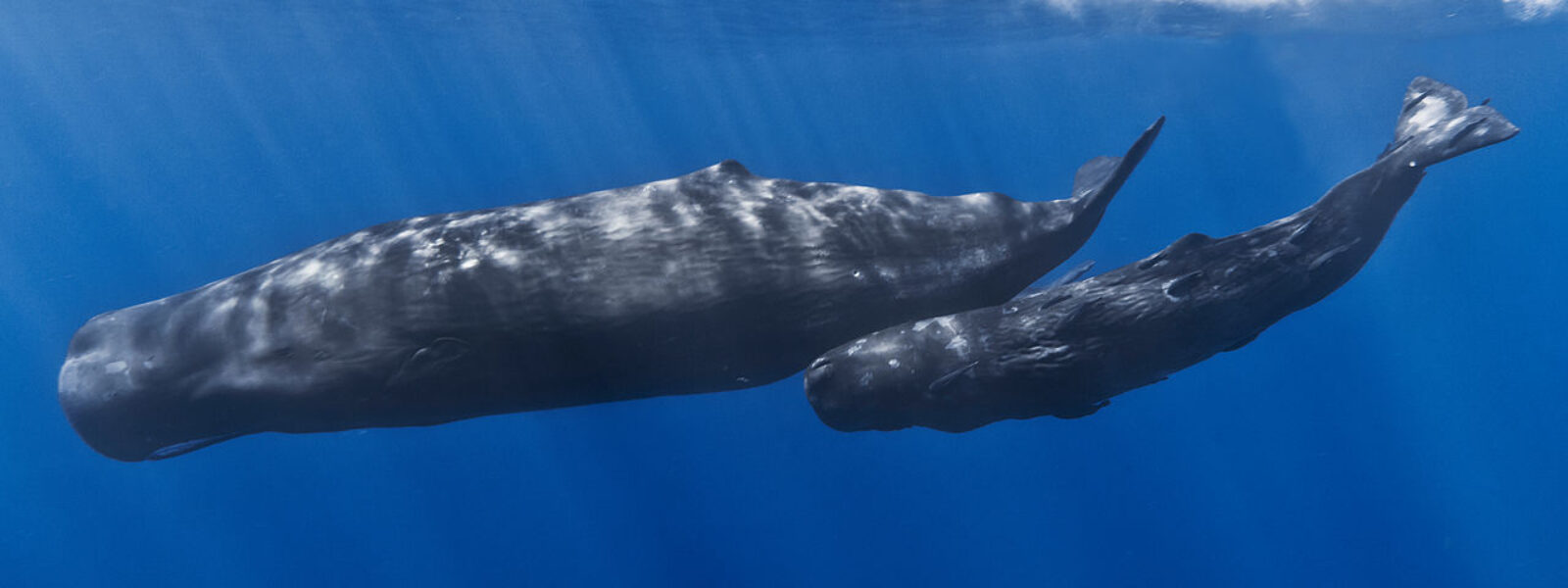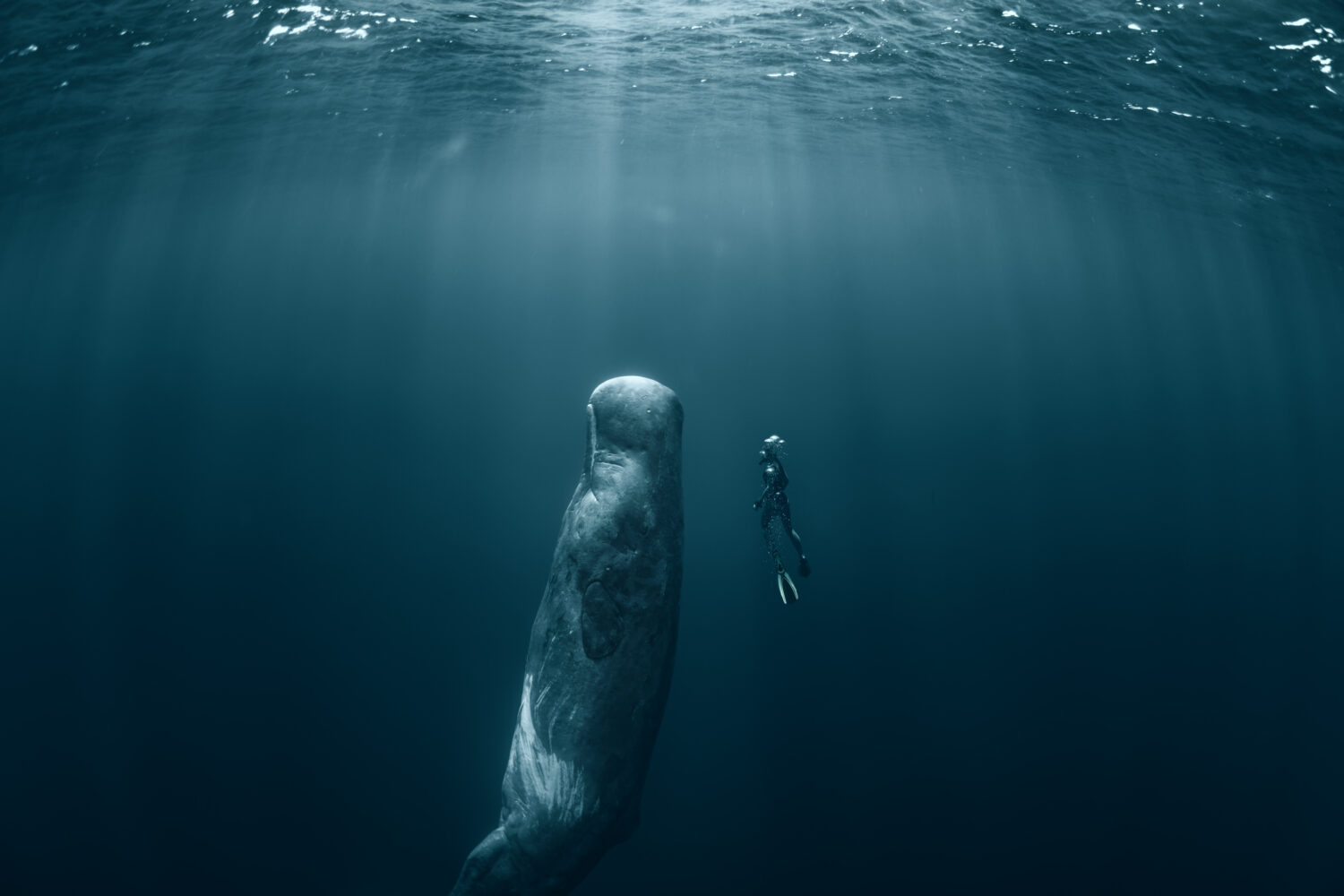
Sperm Whales Learn a Few Tricks
By Mark J. Palmer
The sperm whale has the largest brain on Earth, weighing in at 20 pounds in a male animal which can reach 60 feet long or possibly larger.
What does it use this elaborate brain for? One important brain function is the evaluation of data arriving from the sperm whale’s sonar. The whale issues clicks at a very rapid rate. This beam of sound can be focused by a whale using the oil bodies found in the whale’s enormous head. The sound gets reflected back to the sperm whale, probably along its jaw, and the whale’s brain then has to make sense of these echoes.
Is it food prey like squid? Is it an underwater feature that the whale is familiar with, aiding navigation? Is it a boat? Divers in the water (who report being “scanned” by rumbling low level pulses from a sperm whale that ripple through their bodies)?
Recent research has also shown that sperm whales, like other cetaceans, have a very rich social life, living in small groups of females and young, often accompanied by a larger male. Their groups are believed to have a “culture” – that is, shared ways of living, utilizing resources, and responses to each member of the pod. Knowledge is passed down directly to the new generation.
A new example of sperm whale learning was recently revealed in a scientific paper authored by Canadian biologist and sperm whale expert Dr. Hal Whitehead and colleagues. The paper “Adaptation of sperm whales to open-boat whalers: rapid social learning on a large scale?” was published in the journal Biology Letters of the Royal Society last year.
Dr. Whitehead and his co-authors sorted through digital copies of 19th century whaling in the Pacific Ocean logbooks. Sperm whales were hunted all over the world by Yankee whalers and other countries in the 18thand 19th centuries for the oil that could be boiled out of the carcasses of harpooned whales. That oil in lamps and candles lit the homes of people in America and other countries before the invention of the light bulb. This was the kind of whaling in small boats described by Herman Melville in his novel Moby Dick.
Whitehead et al. were able to demonstrate with some precision the advent of whalers into new parts of the Pacific where sperm whales were at first unfamiliar with the hunters. Particularly interesting was the strike rate, by which hunters were able to harpoon whales. These rates actually dropped by 58% on average within 2.4 years of the whales being initially hunted in an area.

A sperm whale and diver. Photo Credit: Shutterstock.
What was happening? Whitehead and colleagues believe that when faced with the first threat of hunting from small boats, sperm whale populations did not have enough knowledge of the threat to respond. But over a very short time (averaging 2.4 years), the populations would learn new techniques to avoid being struck by harpoons.
The researchers considered alternative explanations, such as that vulnerable sperm whales (old, young, or sick individuals) might account for the success of whalers early on or that the whalers themselves might lose competence over time, but these other explanations did not hold up.
The newly learned techniques by the sperm whales to deal with whalers included, according to the whalers themselves, communication among the whales of the approaching danger, swimming rapidly upwind of the sailing vessels, and attacking the whalers directly.
Sperm whales, when confronted by orcas that prey upon them, developed defense techniques including bunching together and fighting off orcas with teeth and flukes. But these defense techniques were counter-productive when dealing with the threats from whalers. Hence the need for sperm whales to learn and adapt, which they did rapidly.
We continue to learn more and more about the amazing cetaceans and their abilities, but human technology and human-made pollution continue to harm these magnificent sentient beings. We should be asking what we can learn from sperm and other whales and dolphins. And we should better protect them from our own human follies, like pollution, plastics, and entangling fishing gear.
******************************
By the way, Dr. Hal Whitehead has authored a number of books about the sperm whale, having followed and studied them in the oceans for many years. These books are well worth reading if you are interested in this species, my favorite whale personally, although I’ve never actually seen one (except for a dead one).
******************************
